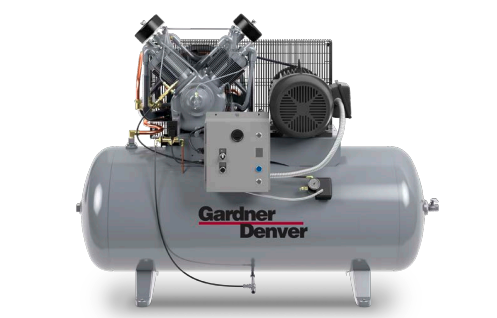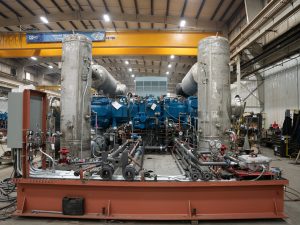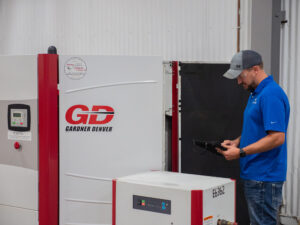Welcome to the world of industrial air compressors, where mysteries abound and every hiss, clank, and whirr is a clue waiting to be uncovered. Put on your detective hat and grab your magnifying glass—it’s time to solve the case of the troublesome air compressor. Let’s dive into the clues and crack these cases wide open!
1. The Case of the Noisy Operation
Symptom: The compressor is louder than a rock concert.
As you step into the mechanical room, you hear the unmistakable racket. Something’s not right. You start piecing together the clues.
Possible Causes:
- Loose Components: Belts, bolts, or panels might be rattling away.
- Worn Bearings: Bearings could be squealing for attention.
- Internal Mechanical Issues: Pistons, valves, or other parts might be causing a commotion.
Troubleshooting Steps:
- Inspect and Tighten: Survey the scene, checking for loose belts, bolts, and panels. Tighten any culprits.
- Check Bearings: Pinpoint the noise. Lubricate or replace those worn bearings.
- Professional Inspection: When in doubt, call a Dearing expert for a thorough examination.
Fun Fact: Regular maintenance can help your compressor stay in harmony, avoiding noisy disruptions.
2. The Air Leak Conundrum
Symptom: The compressor is hissing like a sly serpent.
As you near the compressor, you hear an unmistakable hiss—a sure sign of an air leak. Time to follow the trail and catch the culprit.
Possible Causes:
- Faulty Seals or Gaskets: These might have worn out over time.
- Loose Fittings: Connections could have shaken loose.
- Corrosion or Damage: Rust or physical damage might be the cause.
Troubleshooting Steps:
- Visual Inspection: Look for leaks by listening for hissing sounds or applying soapy water to see bubbles form.
- Repair or Replace: Fix or replace damaged seals, gaskets, and fittings. Tighten loose connections.
- Pressure Test: Conduct a pressure test to pinpoint the leak’s exact location.
Fun Fact: Fixing air leaks not only solves the noise issue but also improves efficiency and saves energy.
3. The Pressure Fluctuation Riddle
Symptom: The air pressure is playing tricks, rising and falling unpredictably.
The gauge is jittery, and so is the machinery. Pressure fluctuations are at play, and it’s up to you to steady the ship.
Possible Causes:
- Dirty or Clogged Filters: Blocking the airflow and causing pressure issues.
- Faulty Pressure Regulator: Failing to maintain consistent pressure.
- Leaking Valves: Letting pressure escape.
Troubleshooting Steps:
- Inspect Filters: Clean or replace dirty or clogged filters.
- Calibrate Regulator: Adjust or replace the pressure regulator.
- Valve Inspection: Test and inspect valves for leaks. Replace as necessary.
Fun Fact: Keeping filters clean and regulators calibrated ensures consistent pressure, like tuning a finely crafted instrument.
4. The Overheating Puzzle
Symptom: The compressor is hotter than a summer barbecue.
The heat is on, and the compressor is feeling the burn. Time to cool things down and solve the overheating enigma.
Possible Causes:
- Inadequate Ventilation: Poor airflow around the compressor.
- Dirty Cooling Fins or Radiators: Blocking cooling airflow with dirt and debris.
- Overloaded Motor: Pushing the compressor beyond its limits.
Troubleshooting Steps:
- Check Ventilation: Ensure proper airflow around the compressor. Clear any obstructions.
- Clean Cooling Components: Regularly clean cooling fins, radiators, and fans.
- Reduce Load: If overheating persists, reduce the load or upgrade to a higher-capacity compressor.
Fun Fact: Proper ventilation and regular cleaning can keep your compressor cool and extend its lifespan, much like a well-ventilated engine.
5. The Excessive Moisture Dilemma
Symptom: Your compressed air is wetter than a rainy day.
The air feels damp, and moisture is wreaking havoc. Let’s try to dry things up and get to the bottom of this wet affair.
Possible Causes:
- Inadequate Drainage: Condensate isn’t draining properly.
- Faulty or Undersized Dryer: Not effectively removing moisture.
- High Humidity Conditions: Humid environments adding extra moisture.
Troubleshooting Steps:
- Check Drainage: Ensure condensate drains are clear and functioning.
- Dryer Maintenance: Maintain air dryers per manufacturer recommendations. Replace desiccant or filters as needed.
- Environmental Control: Consider installing additional moisture separators or controlling the environment.
Fun Fact: Keeping your air dry can prevent corrosion and prolong the life of your equipment.
Conclusion
As a detective of industrial air compressors, every symptom is a clue leading you to the solution. With a keen eye for detail and a systematic approach, you can crack the case and keep your compressor running smoothly. Regular maintenance and prompt troubleshooting will ensure your system stays in top shape. And remember, if the mystery gets too complex, a qualified Dearing technician is just a call away. Happy sleuthing!




